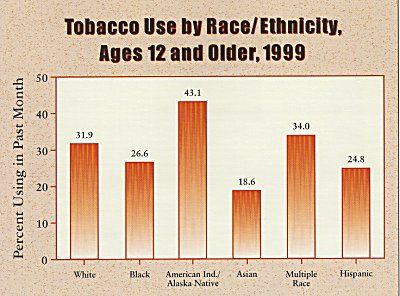Smoking Declines Among High School Males, But Not Females
WASHINGTON-Two new government surveys present a portrait of tobacco use in the United States in 1999 in which cigarette smoking by high school males appears to be declining but more than 30% of the population age 12 or older still smokes, chews, or sniffs tobacco products.
WASHINGTONTwo new government surveys present a portrait of tobacco use in the United States in 1999 in which cigarette smoking by high school males appears to be declining but more than 30% of the population age 12 or older still smokes, chews, or sniffs tobacco products.
Overall, the percentage of high school students who smoked at least once a month dropped to 34.8% last year after rising to 36.4% in 1997 from 34.8% in 1995, according to a survey by the Centers for Disease Control and Prevention (CDC). Its survey covered tobacco use by 15,349 students in grades 9 through 12, most of them between the ages of 14 and 18. Among all the students surveyed, 16.8% said they had smoked on at least 20 of the 30 days prior to the survey.
The decline in smoking for high school students was seen only among males, whose rate was 34.7% in 1999, 37.7% in 1997, and 35.4% in 1995. Among black males, the smoking rate dropped to 21.8% in 1999 from 28.2% in 1997.
Smoking by high school females increased to 34.9% in 1999, from 34.7% in 1997 and 34.3% in 1995.
Nationwide, 66.8 million Americans (30.2%) age 12 or older reported use of tobacco products in 1999, according to the National Household Survey, conducted by the Substance Abuse and Mental Health Services Administration (SAMHSA).
This annual survey of a representative sampling of the US population looked at the use of illicit drugs, alcohol, and tobacco by age groups.
SAMHSA estimated that 57 million Americans (25.8% of the total population) smoked cigarettes last year, 12.1 million (5.5%) smoked cigars, 7.6 million (3.4%) used smokeless tobacco, and 2.4 million (1.1%) smoked pipes.
Five statesKentucky, West Virginia, Minnesota, Delaware, and North Carolinaranked among the top 10 states for cigarette smoking for both those aged 12 to 17 and the general population.
Brand Preference
Adolescents heavily favored three brands over all othersMarlboro (54.5%), Newport (21.6%), and Camel (9.8%), the SAMHSA survey found. No other brand attracted even 2% of the high school smokers.

Cigarette brand preference divided along racial and ethnic lines. Young whites (58.4%) and Hispanics (59.7%) preferred Marlboros, while 73.9% of the black youths chose Newport, a brand marketed heavily to African Americans.
SAMHSA estimated that 1.6 million Americans began smoking cigarettes daily in 1998, about half of them younger than age 18.
By age group, SAMHSA found that 2.2% of 12 year olds smoked cigarettes, as did 14.9% of all those ages 12 to 17. Cigarette smoking by adults aged 18 to 25 reached 39.7%, and the rate was 24.9% for adults 26 years and older.
American Indians and Alaska Natives were more likely than any other race/ethnicity groups to report the use of tobacco products, while Asians had the lowest rate (see Figure).